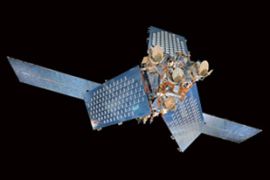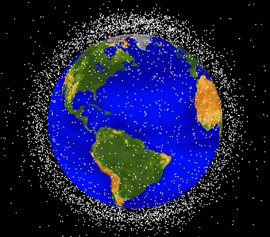US and Russian satellites collide
Collision adds to growing cloud of potentially deadly space debris orbiting Earth.

The Maryland-based company said the collision was not a result of any error on its part and said it would be deploying a spare satellite already in orbit to replace the one destroyed.
The collision took place in an area of space known as low-earth orbit which is used by hundreds of communications and weather-monitoring satellites.
Possible risks
Air Force Colonel Les Kodlick of the US military’s Strategic Command, which monitors thousands of pieces of space debris, said the a debris cloud created by the collision was being tracked to see what kind of threat it may pose.
| Space debris |
|
|
“We believe it’s the first time that two satellites have collided in orbit,” he told the Reuters news agency, adding that the area where the collision took place was “very important for a lot of satellites”.
He said the Command’s Joint Space Operations Centre was tracking 500 to 600 new bits of debris, some as small as 10cm across.
Nasa, the US space agency, said it was assessing the risk posed to the international space station and its crew of three, but said it believed any danger was “very small”.
But Robert Massey, from the Royal Astronomical Society, told Al Jazeera the collision could pose a risk to other objects in orbit.
“Even a fragment of this collision that measures a few centimetres across, if that hits the space station at high speed, of course it could do tremendous damage,” he said.
“It does illustrate the magnitude of the problem – there are 6,000 satellites up there and about 3,000 of them are still functioning. This issue is that when you launch something into space … if they hit objects at high speed they can do a lot of damage and that’s what the risk really is about.”
Serious problem
The space station flies about 500km below the orbit where the collision took place.
The growing amount of space debris is becoming an increasingly serious problem for satellite operators and countries sending humans into orbit.
Travelling at high velocities in space, even tiny pieces of debris such as flecks of paint or a loose bolt have the potential to seriously damage or destroy other spacecraft.
The US Strategic Command says it is tracking more than 18,000 potentially dangerous objects and regularly has to move US defence satellites out of the way of potential harm.
The debris, which can stay in orbit for tens or even hundreds of years, includes larger pieces such as defunct satellites and spent rocket boosters, as well as thousands of smaller pieces such as tools dropped by astronauts.
China was widely criticised by other space-faring nations in 2007 after it destroyed one of its own obsolete weather satellites using a ground-launched ballistic missile.
The apparent test of a Chinese anti-satellite weapon generated a cloud of about 2,500 pieces of debris.
An unnamed US government spokesman told Reuters there was no indication that Tuesday’s collision was the result of deliberate action.

